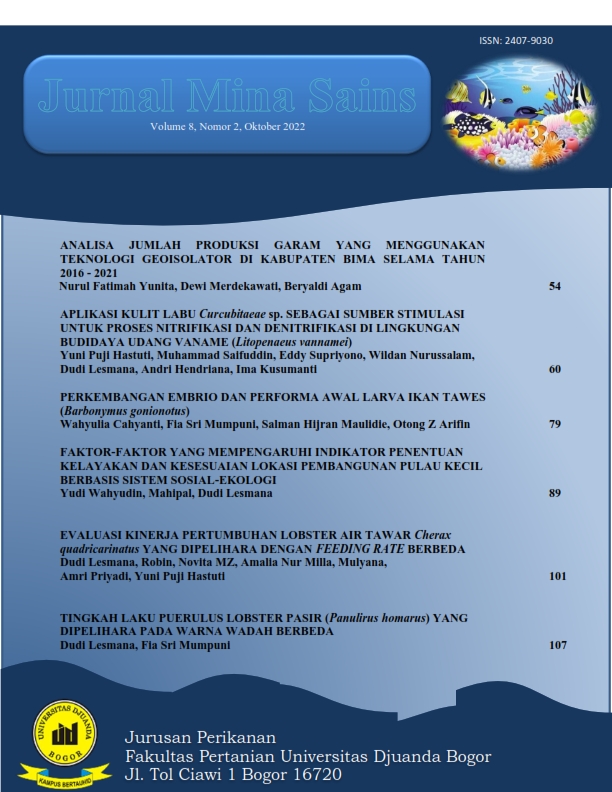TINGKAH LAKU PUERULUS LOBSTER PASIR (Panulirus homarus) YANG DIPELIHARA PADA WARNA WADAH BERBEDA
Main Article Content
Abstract
Cannibalism is one of the factors contributing to the slow growth of lobsters. Cannibalism refers to the practice of one member of a species eating all or a portion of another member of the same species for nourishment. Cannibalism results in bodily deformities including missing fins and skin sores. Cannibalism is stimulated by the chemicals that are released from injured skin (amino acids). The level of cannibalism is said to be triggered by the container's mismatched color. This study set out to ascertain the behavior of lobster, including how frequently they molt and how much cannibalism occurs. A completely randomized design (CRD) with 4 treatments and 3 repetitions was employed in this study. It is well known that one factor in cultivating operations to boost output is the color of the tank. Color of the backdrop water in natural ecosystems to identify feed. In comparison to other treatments, lobsters raised with color tended to molt more frequently (69.33±0.14%) (P <0.05). In comparison to the treatment, lobsters raised in transparent/control containers had a greater percentage of cannibalism (36.00±0.33%) (P< 0.05)
Article Details

This work is licensed under a Creative Commons Attribution-NonCommercial-ShareAlike 4.0 International License.
With the receipt of the article by the Jurnal Mina Sains Universitas Djuanda Editorial Board and the decision to be published, then the copyright regarding the article will be diverted to Jurnal Mina Sains Universitas Djuanda.
Department of Fisheries Djuanda University holds the copyright regarding all the published articles in this journal.
Department of Fisheries Faculty of Agriculture, Universitas Djuanda has the right to multiply and distribute the article. Thanks to the Fisheries Department and Agriculture Faculty Universitas Djuanda that funded this journal sustainability.
The manuscript's authentic and copyright statement submission can be downloaded on this form.
References
Boyd C. E., 1990 Water Quality in Ponds for Aquaculture. Birmingham Alabama (US): Publishing Co.
Daly B, Swingle JS, Eckert GL. 2012. Dietary Astaxanthin Supplementation For Hatchery- Cultured Red King Crab, Paralithoides camtschaticus, Juveniles. Aquaculture Nutrition 19(3) : 312-320.
Drengstig, A. and A. Bergheim. 2013. Commercial land-based farming of European lobster Homarus gammarus (L) in Recirculating Aquaculture System (RAS) using a single cage approach. Aquacultural Engineering, 53:14– 18.
Elnwishy N, Sabri D, Nwonwu F. 2012. The Effect of Difference in Environmental Colors on Nile Tilapia (Oreochromis niloticus) Production Efficiency. International Journal of Agriculture and Biology 14: 516-520.
Fujaya Y, Aslamyah S, Usman Z. 2011. Respons Molting, Pertumbuhan, dan Mortalitas Kepiting Bakau Scylla olivacea yang Disuplementasi Vitomolt melalui Injeksi dan Pakan Buatan. Ilmu Kelautan. 16(4):211-218.
Kibria G. 1993. Studies on molting, molting frequency and growth of shrimp (Penaeus monodon) fed on natural and compounded diets. Asian Fisheries Science. 6: 203–211.
Krol J, Flisiak W, Urbanowicz P, Ulikowski P. 2014. Growth, canibalism and survival relations in larvae of European catfish (Silurus glanis) (Actinopteryhii: siluriformes: siluridae) attemts to mitigate sibling cannibalism. Acta Ichtyologica et Pescatoria. 44: 191-199.
Martin-Robichaud D.J. & Peterson R.H. (1998) E!ects of light intensity, tank colour and photoperiod on swimbladder inflation success in larval striped bass, Morone saxatilis (Walbaum). Aquaculture Research 29,539^547.
Mynott S, Daniels C, Widdicombe S, Stevens M. 2018. Using Camouflage For Conservation: Color Change in Juvenile European Lobster bioRxiv : 1-43.
Nasir NA, Farmer KW. 2017. Effects of Different Artificial Light Colors on The Growth of Juveniles Common Carp (Cyprinus carpio). Mesopotamia Environmental Journal 3(3) : 79-86.
Phillips BF, Kittaka J, 2000. Spinny Lobster: Fisheries and Culture. Osney Mead (GB): Blackwell Science.
Prasetyo ADA, Hariani D, Kuswanti N. 2013. Penambahan Air Kapur dan Bayam pada Pakan untuk Mempersingkat Durasi Moulting Kepiting Bakau Scylla serrata Jantan. LenteraBio. 2(3):271–278.
Rahmadiyah T. 2018. Kanibalisme pada Larva Ikan Lele (Clarias gariepinus): Pengaruh Hormon Testosteron dan Padat Tebar Terhadap Perkembangan Struktur Mulut dan Agresivitas. [Thesis]. Institut Pertanian Bogor.
Rabbani A.G, Zeng C. 2005 Effects of tank colour on larval survival and development of mud crab Scylla serrata (Forskal). Aquac. Res. 36, 1112-1119.
Saekhow S, Thongprajukaew K, Phromkunthong W. 2019. Blue Aquarium Background is Appropriate for Rearing Male Siamese Fighting Fish (Betta splendens). Aquaculture International 27 : 891-903.
Stevens M. 2016. Color Change Phenotypic Plasticity, and Camouflage. Frontiers in Ecology and Evolution 4(51) : 1-10.
Supriyono E, Prihardianto RW, Nirmala K. 2017. The Stress and Growth Responses of Spiny Lobster Panulirus homarus Reared in Recirculation System Equipped by PVC Shelter. AACL Bioflux 10(2) : 147-155.
Verghese B, Radhakrishnan EV, Padhi A. 2007. Effect of environmental parameters on immune response of the Indian spiny lobster, Panulirus homarus (Linnaeus, 1758).Fish and Shellfish Immunology. 23: 928–936.
Vijayakumaran M, Anbarasu M, Kumar TS. 2010. Moulting and Growth in Communal and Individual Rearing of The Spiny Lobster, Panulirus homarus. Journal of the Marine Biological Association of India. 52: 274 -281.
Vijayakumaran M., Maharajan A., Rajalakshmi S., Jayagopal P., Remani M. C., 2014 Early Larval Stages of The Spiny Lobsters Panulirus homarus, Panulirus versicolor, and Panulirus ornatus Cultured under Laboratory Conditions. International Journal of Development Research. 4(2):377-383.
Wahyudin RA. 2018. Dinamika Populasi dan Hubungan Keragaman Genetik Sumberdaya Spiny Lobster. [Disertasi]. Institut Pertanian Bogor.
Wang CA, Li JN,Wang LS, Zhao ZG, Luo L, Du X, Yin JS, Xu QY. 2016. Effects of Tank Colour On Feeding, Growth and Stress Responses of Young Taimen (Pallas, 1773). Journal of Applied Ichthyology 32 : 339-342.

